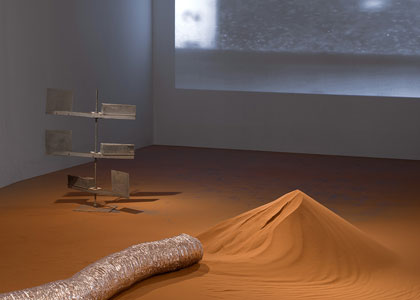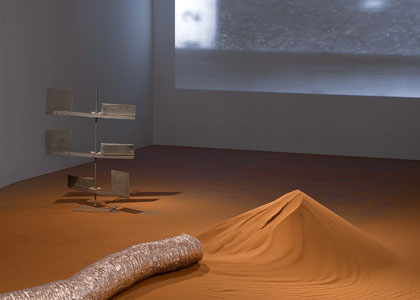Kwisatz Haderach
Curators: Drorit Gur Arie, Or Tshuva
14/09/2017 -
16/12/2017

Ella Littwitz’s project Kwisatz Haderach has two parts: one is featured in the Museum’s entrance concourse, and the other—inside the building. Together they attempt to refine the concept of “home” and examine its interrelations with its place and setting.
In 1982, on the eve of the return of the Sinai Peninsula to Egypt and the evacuation of Yamit, the city’s houses were taken apart, and their walls were stored in the hope that they could be used in the construction of new settlements. The Yamit region was largely built using prefabricated construction, due to the need to settle the area quickly and in keeping with the climate and the sand dunes surrounding it. One of these prefabricated pieces—a 6.5-meter long concrete wall—is now installed in front of the museum. For nearly four decades it was in a “wall cemetery” in the Shalom region, and it still bears signs of what was once a house: traces of interior walls, windows, and ceramic tiles. The project’s other part is a sand dune, likewise cut off from its natural setting, which was introduced into the museum space. The dune is “respirated” by means of industrial fans, taking different shapes and changing in the space over the duration of the show, much like a natural dune.
Littwitz’s research into Yamit’s short history, from its construction to its tearing down, led her to explore the environmental conditions, and mainly the geo-morphological phenomenon of sand migration, taking shape and dissolving rapidly, like the city itself. This phenomenon was linked in her work, among others, to Frank Herbert’s novel Dune (Holit in Hebrew, as the name of one of the evacuated settlements), which addresses attempts by political and religious groups to settle and dominate a hostile wilderness. Kwisatz Haderach, the title of the project—a term derived from Jewish literature, denoting a leap of distance, contracting the path, or shortening the way—is a quality attributed in Herbert’s novel to the protagonist.
The installation extends along the axis between the fictive and the documentary, the personal and the collective, the artificial and the natural, touching upon questions of temporality, relics, and traces. It is centered on a quandary regarding the feasibility of settling a constantly changing geopolitical sphere; an (ostensibly doomed) attempt to settle that which migratesand shifts and to shift that which is settled.
Thanks to Prof. Itzhak Katra and Nitzan Swet, Aeolian Simulation Laboratory, Ben Gurion University of the Negev; thanks also to Nachum Shimshony, Shlomo Shkedi, Zahava Shaked (The Yamit Haggadah), Hezie Lavi, and Zohar Hayat.



